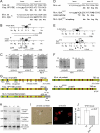An Xpb mouse model for combined xeroderma pigmentosum and cockayne syndrome reveals progeroid features upon further attenuation of DNA repair
- PMID: 19114557
- PMCID: PMC2643825
- DOI: 10.1128/MCB.01229-08
An Xpb mouse model for combined xeroderma pigmentosum and cockayne syndrome reveals progeroid features upon further attenuation of DNA repair
Abstract
Patients carrying mutations in the XPB helicase subunit of the basal transcription and nucleotide excision repair (NER) factor TFIIH display the combined cancer and developmental-progeroid disorder xeroderma pigmentosum/Cockayne syndrome (XPCS). Due to the dual transcription repair role of XPB and the absence of animal models, the underlying molecular mechanisms of XPB(XPCS) are largely uncharacterized. Here we show that severe alterations in Xpb cause embryonic lethality and that knock-in mice closely mimicking an XPCS patient-derived XPB mutation recapitulate the UV sensitivity typical for XP but fail to show overt CS features unless the DNA repair capacity is further challenged by crossings to the NER-deficient Xpa background. Interestingly, the Xpb(XPCS) Xpa double mutants display a remarkable interanimal variance, which points to stochastic DNA damage accumulation as an important determinant of clinical diversity in NER syndromes. Furthermore, mice carrying the Xpb(XPCS) mutation together with a point mutation in the second TFIIH helicase Xpd are healthy at birth but display neonatal lethality, indicating that transcription efficiency is sufficient to permit embryonal development even when both TFIIH helicases are crippled. The double-mutant cells exhibit sensitivity to oxidative stress, suggesting a role for endogenous DNA damage in the onset of XPB-associated CS.
Figures





Similar articles
-
Phenotypic heterogeneity in the XPB DNA helicase gene (ERCC3): xeroderma pigmentosum without and with Cockayne syndrome.Hum Mutat. 2006 Nov;27(11):1092-103. doi: 10.1002/humu.20392. Hum Mutat. 2006. PMID: 16947863
-
Lack of CAK complex accumulation at DNA damage sites in XP-B and XP-B/CS fibroblasts reveals differential regulation of CAK anchoring to core TFIIH by XPB and XPD helicases during nucleotide excision repair.DNA Repair (Amst). 2012 Dec 1;11(12):942-50. doi: 10.1016/j.dnarep.2012.09.003. Epub 2012 Oct 17. DNA Repair (Amst). 2012. PMID: 23083890 Free PMC article.
-
XPB and XPD helicases in TFIIH orchestrate DNA duplex opening and damage verification to coordinate repair with transcription and cell cycle via CAK kinase.DNA Repair (Amst). 2011 Jul 15;10(7):697-713. doi: 10.1016/j.dnarep.2011.04.028. Epub 2011 May 14. DNA Repair (Amst). 2011. PMID: 21571596 Free PMC article. Review.
-
Persistence of repair proteins at unrepaired DNA damage distinguishes diseases with ERCC2 (XPD) mutations: cancer-prone xeroderma pigmentosum vs. non-cancer-prone trichothiodystrophy.Hum Mutat. 2008 Oct;29(10):1194-208. doi: 10.1002/humu.20768. Hum Mutat. 2008. PMID: 18470933 Free PMC article.
-
XPB: An unconventional SF2 DNA helicase.Prog Biophys Mol Biol. 2015 Mar;117(2-3):174-181. doi: 10.1016/j.pbiomolbio.2014.12.005. Epub 2015 Jan 30. Prog Biophys Mol Biol. 2015. PMID: 25641424 Review.
Cited by
-
MicroRNA-200c reverses drug resistance of human gastric cancer cells by targeting regulation of the NER-ERCC3/4 pathway.Oncol Lett. 2019 Jul;18(1):145-152. doi: 10.3892/ol.2019.10304. Epub 2019 May 2. Oncol Lett. 2019. PMID: 31289483 Free PMC article.
-
Deficiency in nucleotide excision repair family gene activity, especially ERCC3, is associated with non-pigmented hair fiber growth.PLoS One. 2012;7(5):e34185. doi: 10.1371/journal.pone.0034185. Epub 2012 May 16. PLoS One. 2012. PMID: 22615732 Free PMC article.
-
Age-related neuronal degeneration: complementary roles of nucleotide excision repair and transcription-coupled repair in preventing neuropathology.PLoS Genet. 2011 Dec;7(12):e1002405. doi: 10.1371/journal.pgen.1002405. Epub 2011 Dec 8. PLoS Genet. 2011. PMID: 22174697 Free PMC article.
-
DNA damage responses in ageing.Open Biol. 2019 Nov 29;9(11):190168. doi: 10.1098/rsob.190168. Epub 2019 Nov 20. Open Biol. 2019. PMID: 31744423 Free PMC article. Review.
-
Hydrogen peroxide induced genomic instability in nucleotide excision repair-deficient lymphoblastoid cells.Genome Integr. 2010 Dec 22;1(1):16. doi: 10.1186/2041-9414-1-16. Genome Integr. 2010. PMID: 21176161 Free PMC article.
References
-
- Andressoo, J. O., and J. H. Hoeijmakers. 2005. Transcription-coupled repair and premature ageing. Mutat. Res. 577179-194. - PubMed
-
- Andressoo, J. O., J. Jans, J. de Wit, F. Coin, D. Hoogstraten, M. van de Ven, W. Toussaint, J. Huijmans, H. B. Thio, W. J. van Leeuwen, J. de Boer, J. M. Egly, J. H. Hoeijmakers, G. T. van der Horst, and J. R. Mitchell. 2006. Rescue of progeria in trichothiodystrophy by homozygous lethal Xpd alleles. PLoS Biol. 4e322. - PMC - PubMed
-
- Andressoo, J. O., J. R. Mitchell, J. de Wit, D. Hoogstraten, M. Volker, W. Toussaint, E. Speksnijder, R. B. Beems, H. van Steeg, J. Jans, C. I. de Zeeuw, N. G. Jaspers, A. Raams, A. R. Lehmann, W. Vermeulen, J. H. Hoeijmakers, and G. T. van der Horst. 2006. An Xpd mouse model for the combined xeroderma pigmentosum/Cockayne syndrome exhibiting both cancer predisposition and segmental progeria. Cancer Cell 10121-132. - PubMed
-
- Bahar, R., C. H. Hartmann, K. A. Rodriguez, A. D. Denny, R. A. Busuttil, M. E. Dolle, R. B. Calder, G. B. Chisholm, B. H. Pollock, C. A. Klein, and J. Vijg. 2006. Increased cell-to-cell variation in gene expression in ageing mouse heart. Nature 4411011-1014. - PubMed
-
- Bartke, A. 2005. Minireview: role of the growth hormone/insulin-like growth factor system in mammalian aging. Endocrinology 1463718-3723. - PubMed
Publication types
MeSH terms
Substances
Grants and funding
LinkOut - more resources
Full Text Sources
Molecular Biology Databases
Research Materials
